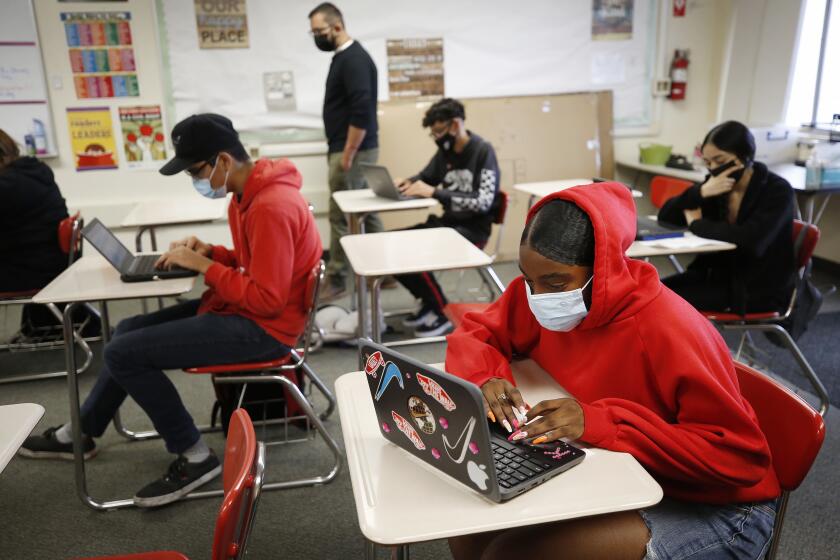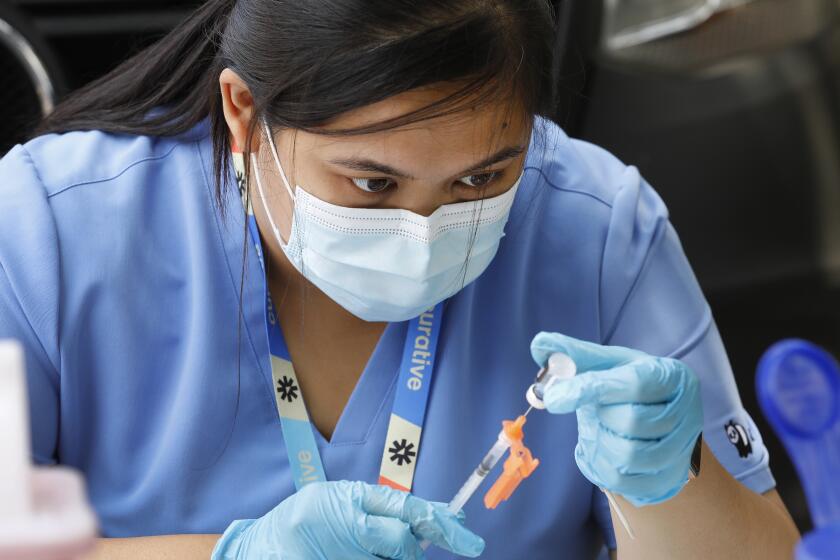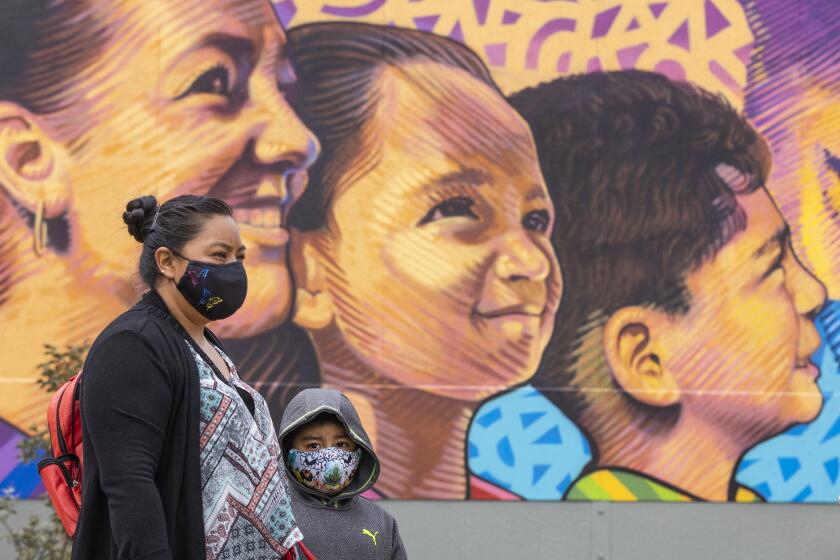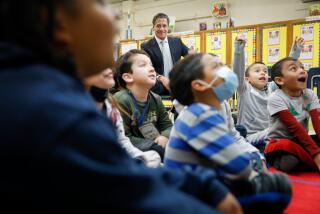Delta variant is sucking the joy out of back-to-school 2021
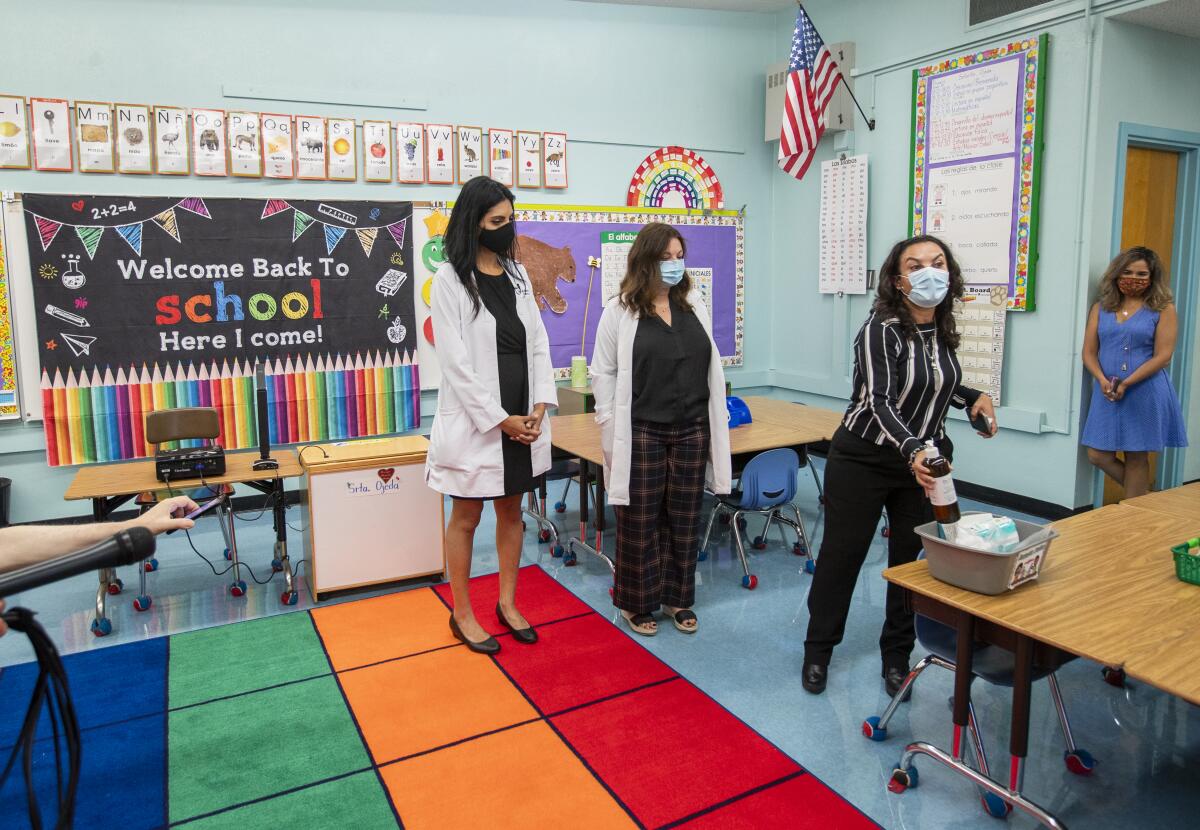
Back-to-school 2021, with California campuses fully open for 6 million children, was supposed to herald relief — even celebration — for a mostly normal school year ahead. But a surge in the highly contagious Delta variant of the coronavirus has reignited parents’ anxiety — and, for many, the safety and quality of schooling once again feel uncertain and tenuous.
“I wanted to be excited about a new school year, but now I am having to think: ‘Am I putting our health at risk by going to school in person?’” said Irma Villalpando, who has two high school daughters at the Maywood Center for Enriched Studies. “I am feeling very sad because I think that it is going to be another very difficult year.”
Some parents have frantically explored limited online options. And questions over safety protocols are taking on an urgent tone: What happens if someone at my child’s school tests positive? What happens if my child is exposed — will their class be quarantined? Will their school close? Are all teachers vaccinated? What about coronavirus testing?
The Los Angeles County Department of Public Health disclosed last week that there were seven outbreaks in youth settings during the final week of July — the most since December. Most were associated with youth sports — and heavily associated with poor health safety practices, such as inconsistent mask wearing, lack of physical distancing and failing to isolate sick individuals and their close contacts.
Recorded cases and hospitalizations are up for children — although without any associated deaths, said county Public Health Director Barbara Ferrer. Documented cases among children through age 11 increased from 47 to 319 when comparing the two-week period ending June 26 with the two weeks ending July 24, according to county data. For ages 12 to 17, the number of cases rose from 34 to 211. Hospitalizations remained rare, about 1 in 100 cases among those 12 to 17.
“We recognize that, given our recent increases in cases, there is anxiety around school reopening,” Ferrer said.
Even so, there’s no indication the Delta variant will stop campuses from reopening for full-time, in-person classes — albeit with safety measures, most notably an indoor mask mandate and, in some places, outdoors as well.
In August, K-12 students will return to school. For many districts, summer school has provided a preview of classroom life with mask mandates.
Gov. Gavin Newsom on Friday uttered a refrain common to him and other political and education leaders.
“Over the course of the next few weeks, we’re getting all our kids safely back into in-person instruction,” Newsom said at an event highlighting reopened campuses in San Bernardino. “And we’re doing it in a sustainable way.”
Ferrer, L.A. County Office of Education Supt. Debra Duardo and others spoke in similar terms during an online forum for parents earlier in the week, saying that returning to campus is vital because it offers direct academic intervention, crucial social interaction and ramped-up mental health support.
“We are confident schools have done an excellent job following all the mitigation strategies to prevent the spread of COVID,” Duardo said.
Online options are limited
Although the state has required school districts to provide an online option, “hybrid learning” — a combination of online and in-person instruction offered last year — is gone.
In Los Angeles Unified, parents had until Friday to proactively choose online classes — an independent-study option that is much different from the distance learning of the last school year. Otherwise, children in the nation’s second-largest school system will be expected to show up on campus for the first day of school Aug. 16.
By Friday morning, L.A. Unified was reporting that 10,280 students were opting for online, just over 2% of last year’s K-12 enrollment of 465,000.
There was a lot of last-minute decision-making. Some parents said they were being forced to choose between unresolved safety concerns and an inferior online experience.
“To be honest, we haven’t decided yet,” said west San Fernando Valley parent Lauren Dragan on Wednesday night, two days before the deadline. “I know that sounds outrageous.”
Brian Bartelt, who has three children who would normally attend Richland Elementary in Mar Vista, tried to join a district webinar about the online option but was denied because it was maxed out at 1,000 participants. He called the process “insane.”
Younger kids have no vaccine option
A troubling issue for many parents is that vaccines — which experts say are the best protective strategy — are not yet approved for use in children younger than 12. And, according to L.A. County data, fewer than half of children ages 12 to 15 have received a dose, while about 4 in 10 teenagers 16 and older remain unvaccinated.
“I am appalled and insulted by the push to crowd children under 12 years, who are NOT eligible for vaccination into full day and after-school programs,” Bridget Gordon, who has a 10-year-old in a dual-language program, wrote in an email.
About 83% of school-district employees are vaccinated, according to estimates submitted to the county by most districts.
Quarantine protocols are questioned
Among many new concerns, parents perceive a lack of clarity regarding quarantine protocols if a student or teacher is exposed to the virus or tests positive.
“What defines ‘close contact’?” said Dragan, who has a child entering kindergarten in Sherman Oaks and was among more than 50 parents who provided input to The Times. “Who needs to quarantine in addition to the child who tested positive? Is it a desk mate? The teacher? All the students in a class? And what education plans are in place for classrooms in quarantine?”
What happens depends on the situation, Ferrer said.
The variant’s ability to spread among the vaccinated is worrisome, experts said, but it shouldn’t preclude kids from heading back to school.
All coronavirus cases, including those at schools, must be reported to the county health department. Those with infections must self-isolate, and county health officials will “be aggressive” about contact tracing. Close contacts who are not vaccinated must quarantine for up to 10 days.
Three or more potentially linked cases at one school over 14 days could represent an outbreak and could lead to a more aggressive response, such as having a group of students or even a class quarantine at home. A school closure would be unlikely, Ferrer said.
L.A. Unified consultant Jim Morris, a formerly retired senior administrator who is helping marshal reopening efforts, said the goal was to follow the guidance of county health experts in responding to an infection among students or staff. The district has created a holding space at each school for sick students and a separate one for students exposed to someone who’s ill — until a parent or guardian can pick up the child.
Physical distancing has ended
Another area of concern among parents is the end of mandated physical distancing. L.A. County guidelines call for schools to provide as much distance “as possible.”
Because of space limitations, the return to full-time on-campus classes in L.A. Unified means an end to that district’s six-foot distancing, which was in place when campuses reopened in April. At the time, about one in four students returned, making it easier to spread out. During summer school — when fewer than one in 10 students took class on campus — the minimum required distance was three feet, but greater separation was frequently possible.
A kindergarten classroom presented during a recent district tour of safety measures was set up with shared desks pushed together rather than individual desks, where students would be farther apart.
Local and national health authorities assert that physical distancing is not necessary with other strategies in place — most notably masking but also including improved ventilation, more frequent cleaning and strong hygiene practices, such as frequent hand-washing. They also emphasize that sick children and staff should stay home.
Shutdowns could mean a choppy year
Large numbers of parents worry the year will be disrupted by classroom quarantines and even campus shutdowns — and this includes parents who are dismissive of the need for strict safety protocols as well as those who strongly support them.
“As a single mom, I personally have a strong stake in schools reopening so I can work and put food on the table, as do many parents,” said Liza Castillo, a San Fernando Valley parent with children in second and fourth grades. “I am tired of the goal posts moving. We should be able to assess risks for ourselves and our children.”
“Virtual school didn’t serve the needs of my kids and many others,” said Pam Schmidt, a Westchester resident who is raising teenage grandsons who attend a charter school. “Not only was learning difficult, their mental health and self-esteem were impaired.”
Other parents would feel more comfortable remaining online but worry about academic quality. In L.A. Unified, online students must enroll in the district’s City of Angels independent study program, which is gearing up to handle close to 10 times more students than before the pandemic. Students in the revamped program will receive less live instruction than students who attend in person.
“I feel like the LAUSD is kicking me out of my neighborhood school and its community to some division of home schooling that isn’t fully ready or prepared to teach thousands of students with varying needs,” said Teresa Gaines, a parent leader with the advocacy group Reclaim Our Schools L.A.
Similar parent concerns are echoing across other school systems as parents gird for the possibility of a worsening Delta variant surge.
County officials said the latest surge is showing signs of leveling off somewhat. The daily test positivity rate on Saturday was 4.7%, a small decrease from last week’s rate of 6.3%.
“I thought I would be sending my children back,” said DeAnne Ozaki, a parent in the Santa Monica-Malibu Unified School District. “My daughter is vaccinated and I was hoping that the number of COVID cases would be low and it would be safe for my son. Unfortunately, the Delta variant has changed everything.”
Parents in Pasadena complained to the school board about limited online offerings and last-minute uncertainties. Raising similar concerns, Glendale parent Mary Ashley pleaded with officials to put a webcam in the regular classes.
Laura Giles, who has four children in Lancaster, is among a number of parents who object to the school mask mandate. Last week, the Orange County Board of Education voted to sue Newsom over the rule.
“I consider it a greater risk to their health to be masked for close to seven hours than any risk of serious illness from COVID-19 — even the Delta variant,” said Giles. Her children enjoyed a summer school program, except for the masks: “They come home complaining of headaches and say it is very hard to breathe.”
Then there are the parents who are not worried — or who at least see the decision as a no-brainer.
“Easy,” said Joanna Belson, who has a child at Reed Middle School and another at North Hollywood High. She gradually developed trust in L.A. Unified’s ability to provide a safe environment. “They are going. ... My kids are desperate to socialize and do sports.”
More to Read
Sign up for Essential California
The most important California stories and recommendations in your inbox every morning.
You may occasionally receive promotional content from the Los Angeles Times.
